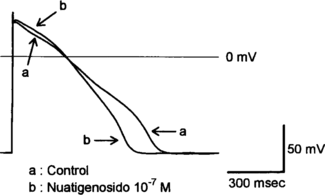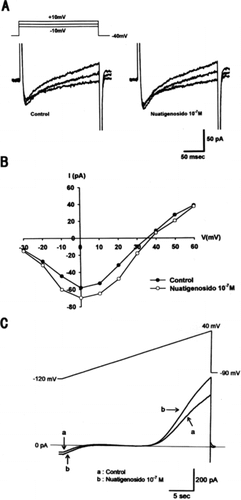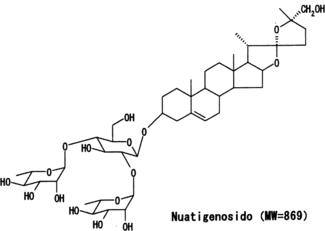Abstract
The root of Solanum sisymbriifolium. Lam (Solanceae), a perennial herb, has been used as a traditional medicine possessing diuretic and antihypertensive properties in Paraguay. It was reported that extracts from this plant exerted hypotensive effects in rats. Nuatigenosido was isolated from the extract as one of the prospective active compounds. We have investigated its pharmacological actions. The current study demonstrated the following results: (1) Nuatigenosido at 100 µg/kg and 1 mg/kg i.v. lowered blood pressure in rats, (2) nuatigenosido at 10−6 and 10−5 M augmented the contractile force in the right atrium of a bullfrog, and (3) nuatigenosido at 10−7 M increased the overshoot amplitude in frog atrial myocytes, action potential durations were shortened, the calcium current (ICa) was increased, and the delayed outward potassium current was increased. From these results, it is suggested that nuatigenosido may play an important role in the therapeutic effects of this herb.
Introduction
The root of Solanum sisymbriifolium. Lam (Solanaceae) is a perennial herb found in eastern Paraguay. Traditionally, its crude extract has been used as a diuretic and an antihypertensive (Gonzales Torrez, Citation1992). We demonstrated that the crude extract exerted a hypotensive action in rats (Ibarrola et al., Citation1996). We also found that two butanol fractions of the extract exerted a hypotensive action (Ibarrola et al., Citation2000). Nuatigenosido was isolated from one of these two fractions, and its chemical structure was determined by Ferro et al. (Citation2002) and found proved to be nuatigenosido (). The current study was designed to elucidate cardiovascular profiles and mechanisms of nuatigenosido and compare these activities with those of the original extract.
Materials and Methods
Plant material and its extraction and isolation
Roots of Solanum sisymbriifolium. Lam (3 kg) were collected in Paraguay and identified by N. Soria (Facultad de Ciencias Químicas, Universidad Nacional de Asunción, Paraguay). A voucher specimen was deposited in the Herbarium FCQ (Facultad de Ciencias Químicas, Universidad Nacional de Asunción, Paraguay) under the number Soria 5248.
Powdered air-dried roots were extracted by reflux with ethanol-water (7:3). The extract was filtered, concentrated, and freeze-dried, which was subjected to liquid-liquid fractionation, and then the butanolic fraction was obtained. An aliquot of this fraction was separated by MPLC (medium-pressure liquid chromatography) on silica gel eluted with a gradient of CHCl3/MeOH (chloroform-methanol). Finally, the most active fraction was purified, and the structure of the isolated compound was determined by a spectroscopic method with acid hydrolysis (Ferro et al., Citation2002). This compound proved to be nuatigenin-3-O.-β.-chacotriose, which was already reported to be isolated from the bulbs of Triteleia lactea. (Mimaki et al., Citation1995). Nuatigenin-3-O.-β.-chacotriose, nuatigenosido, was dissolved in 10% ethanol, 40% propyleneglycol, and distilled water, and used for the experiments.
Blood pressure measurements
Wistar rats weighing 250–300 g were anesthetized with pentobarbital sodium (60 mg/kg, i.p.). Their blood pressure was measured with a pressure transducer connected to a rigid polyethylene tube inserted into the right common carotid artery.
Right atrial preparation
The heart was excised from the bullfrog after crushing down the spinal cord. Its right atrium was removed in Ringer's solution saturated with 95% O2 and 5% CO2 (pH 7.4) and containing (mM): NaCl, 90.6; KCl, 2.5; CaCl2, 2.5; MgCl2, 5.0; NaHCO3, 20.0; glucose, 10.0. Contraction was caused by electrical stimulation, and contractile force was recorded with an isotonic force displacement transducer.
Cell dispersion, membrane potential, and current measurements
Single atrial cells were isolated by means of a procedure described by Hume and Giles (Citation1981). Briefly, the right atrium removed from the bullfrog (Rana catesbeiana.) was incubated in Ca2+-free Ringer's solution, the saturation of which was maintained with 95% O2 and 5% CO2 (pH 7.4) and containing (mM): NaCl, 90.6; KCl, 2.5; MgCl2, 5.0; NaHCO3, 20.0; glucose, 10.0. Electrophysiological experiments were performed using approximately the same methods as described by Hirota et al. (Citation1986). Glass microelectrodes filled with 130 mM KCl and having resistances of 3–6 MΩ were introduced into the isolated cells by suction immersed in a tissue bath. All experiments were performed at room temperature (20–22°C).
Results and Discussion
Blood pressure measurements
Nuatigenosido at doses of 100 µg/kg and 1 mg/kg i.v. decreased blood pressure in anesthetized rats ().
Contractile force measurements
Nuatigenosido at 10−6 and 10−5 M augmented the contractile force in the bullfrog right atrium ().
Action potential measurements and voltage-clamp experiments
Nuatigenosido was applied to frog atrial cells at a concentration of 10−7 M. As shown in , nuatigenosido increased the amplitude of the overshoot potential, and the plateau height was slightly increased. It also shortened the action potential duration significantly. The collected data are shown in . The solvent did not affect the action potential configuration (data not shown).
Table 1. Effects of nuatigenosido on the action potentials in bullfrog atrial myocytes.
Figure 3 A typical tracing of effects of nuatigenosido on action potential configuration in a bullfrog atrial cell.

Nuatigenosido at 10−7 M increased the amplitude of the peak slow inward calcium currents (ICa), and the current decay of ICa was increased, as shown in . represents the current-voltage relationships. This increase in ICa may contribute to the increase in plateau height of the action potential configuration and the increase in contractile force. An ascending voltage ramp from −120 mV to +40 mV was applied to examine the background and delayed outward currents, as shown in . At the test voltages positive to K equilibrium potentials, small outward currents were observed between −90 mV and −10 mV, and the delayed outward currents developed at the voltages positive to −10 mV. The inward currents were observed at the more negative voltages than K equilibrium potentials. At the test voltages between − 90 mV and − 10 mV, no obvious change in the outward currents in this negative slope region (not prominent in the frog atrium) was caused with nuatigenosido, suggesting no alteration of the inwardly rectifying potassium current. On the other hand, the delayed outward current was increased with nuatigenosido, which is probably responsible for the shortening of the action potential duration.
Figure 4 Effects of nuatigenosido on calcium current and background current. (A) Typical tracings of calcium current: The slow inward calcium currents (ICa) were measured by delivering the depolarizing clamp pulses with 200-ms duration from a holding potential of −40 mV every 5 s. These tracings were obtained with clamp pulses from a holding potential of −40 mV to −10, 0, and +10 mV at increasing voltage steps, (B) Current (pA)-voltage (mV) relationships of calcium current, and (C) Current changes under the ramp-clamp: The ramp-clamp pulse (30-s duration) from −120 mV to 40 mV was applied.

Mimaki et al. (Citation1995) demonstrated that nuatigenosido isolated from Triteleia lactea. possessed the inhibitory activity on cyclic AMP phosphodiesterase. This enzyme inhibition of the compound may be associated with the nuatigenosido-induced peripheral vasodilatation and the increase in contractile force and ICa in the heart by increasing the intracellular cyclic AMP levels. It can be said that to some extent vasodilatation and cardiotonic action induced by nuatigenosido seem to be involved in the clinical efficaciousness characteristics of this plant such as hypotension and diuresis.
Acknowledgments
We thank Ms. Charley L. Thorp and Dr. Rami Suzuki for critically reading the paper.
References
- Clark RB, Nakajima T, Giles W, Kanai K, Momose Y, Szabo G (1990): Two distinct types of inwardly rectifying K+ channels in bull-frog atrial myocytes. J Physiol 424: 229–251. [INFOTRIEVE], [CSA]
- Ferro EA, Alvarenga NL, Ibarrola DA, Ibarrola MH, Ravelo AG (2002): Structure and biological activity of two saponins isolated from Solanum sisymbrifolium. Lam. 1 Latin-American conference of Pharmaceutical Fine Chemistry, C-14, University of Salamanca, Salamanca, Spain.
- Gonzales Torrez DM (1992): Catalog of Medicinal Plants (with Useful Food Values) Used in Paraguay. Asuncion, El Pais, p. 312, 452.
- Hirota K, Momose Y, Takeda R, Nakanishi S, Ito Y (1986): Prolongation of the action potential and reduction of the delayed outward K+ current by halothane in single frog atrial cells. Eur J Pharmacol 126: 293–295. [INFOTRIEVE], [CSA], [CROSSREF]
- Hume JR, Giles W (1981): Active and passive electrical properties of single bullfrog atrial cells. J Gen Physiol 78: 18–43. [CSA], [CROSSREF]
- Ibarrola DA, Ibarrola MH, Vera C, Montalbetti Y, Ferro EA (1996): Hypotensive effect of crude root extract of Solanum sisymbriifolium. (Solanaceae) in normo- and hypertensive rats. J Ethnopharmacol 54: 7–12. [INFOTRIEVE], [CSA], [CROSSREF]
- Ibarrola DA, Ibarrola MH, Montalbetti Y, Heinichen O, Alvarenga N, Figueredo A, Ferro EA (2000): Isolation of hypotensive compounds from Solanum sisymbriifolium. Lam. J Ethnopharmacol 70: 301–307. [CSA], [CROSSREF]
- Mimaki Y, Nakamura O, Sashida Y, Nikaido T, Ohmoto T (1995): Steroidal saponins from the bulbs of Teriteleia lactea. and their inhibitory activity on cyclic phosphodieaterase. Phytochemistry 38: 1279–1286. [INFOTRIEVE], [CSA], [CROSSREF]

